A time may come when you may need to train your dog to use a ramp. You may not notice it but as the years pass, your dog also grows with you. They will eventually start to slow down as they age and it’s not uncommon for our pooches to develop mobility problems along the way.
Younger dogs may also develop orthopedic problems and for some very small dogs or breeds with short legs and long bodies, like Dachshunds and Corgis, jumping from cars, the bed or the couch can be problematic.
Your beloved canine pal shouldn’t have to struggle to get up on the couch or bed or into the car. And, depending on their size, it may be difficult for you to constantly lift and carry them.
Fortunately, there is a wide range of dog ramps suitable for any dog and in any location. If you have a senior dog, a dog with arthritis, or with other mobility issues, dog ramps can make their life, and yours, a whole lot easier!
But, There’s One Problem...
Many dog owners purchase ramps to help their dogs only to realise that their dog is reluctant to use the ramp at all.

We can't blame these dogs though. Some dogs are reluctant to try new things for the first time. Unless a dog has been enrolled in the sport of agility, or military-trained, a ramp is something odd, and it can be quite intimidating for them.
You Can Teach An Old Dog New Tricks!
You bought your dog a ramp expecting that he’d just walk on it first shot.
Easy, right?
… But he just ignored it. Why? Isn’t it obvious that the ramp is there to help?!
You see, some dogs have problems associating with novel items.
In order to help our dogs out, we must put ourselves in their shoes (or better, on their paws!) to help them overcome this uneasiness and encourage them to walk up and down their new ramp with confidence.
The best way to train a dog to use a ramp is to go slow and steady. Never force your dog up but actually allow him to explore and learn more about the ramp on his own in the first place.
You And Your Dog Are On This, Together!
Remember that this is one thing that you and your dog can accomplish together.
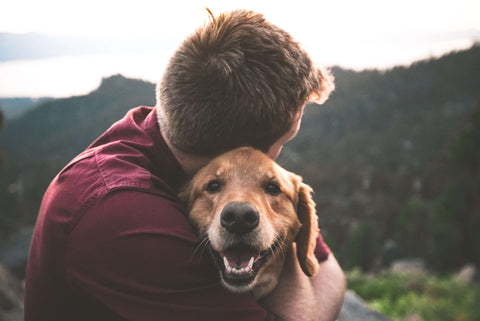
In order to train your dog to use a ramp here are the things that you will need:
- A dog ramp
- Tasty treats your pooch loves
- A few large books or pieces of furniture (we’ll explain this in a sec…)
- Lots of patience and encouragement!
Depending on both your patience level and your dog’s behaviour, you'll have him walking up and down the ramp without hesitation in just two to three days.
As always, a gradual approach is a must. We want to focus on creating a positive association with the ramp first while moving onto providing reinforcement until your dog is perfectly comfortable going up and down the ramp on his own.
But before we start, make sure that you get your dog a suitable ramp to use.
A Few Tips In Choosing a Good Ramp For Your Dog
Buying a ramp can be a bit tricky. Depending on your needs or your dog’s requirements, there are different kinds of ramps that you can choose from.
Indoor ramps for dogs are usually made of wood or plastic and are used for couches and beds while outdoor ramps for dogs are made of plastic or aluminium and best when taking your dog for a ride to help him go up and down the car with ease.
You can also choose from a telescopic or folding ramp depending on your preferences. Initially, look for a ramp with a good gripping surface. This allows your dog more secure footing. Also, remember that the wider the ramp, the better, as it helps your dog walk with confidence.
The Heeve 'Up-Ya-Get' Wooden Dog Ramp For Beds is one of our best selling indoor ramps while we recommend the Heeve 'Up-Ya-Get' Telescopic Dog Ramp for outdoor use.
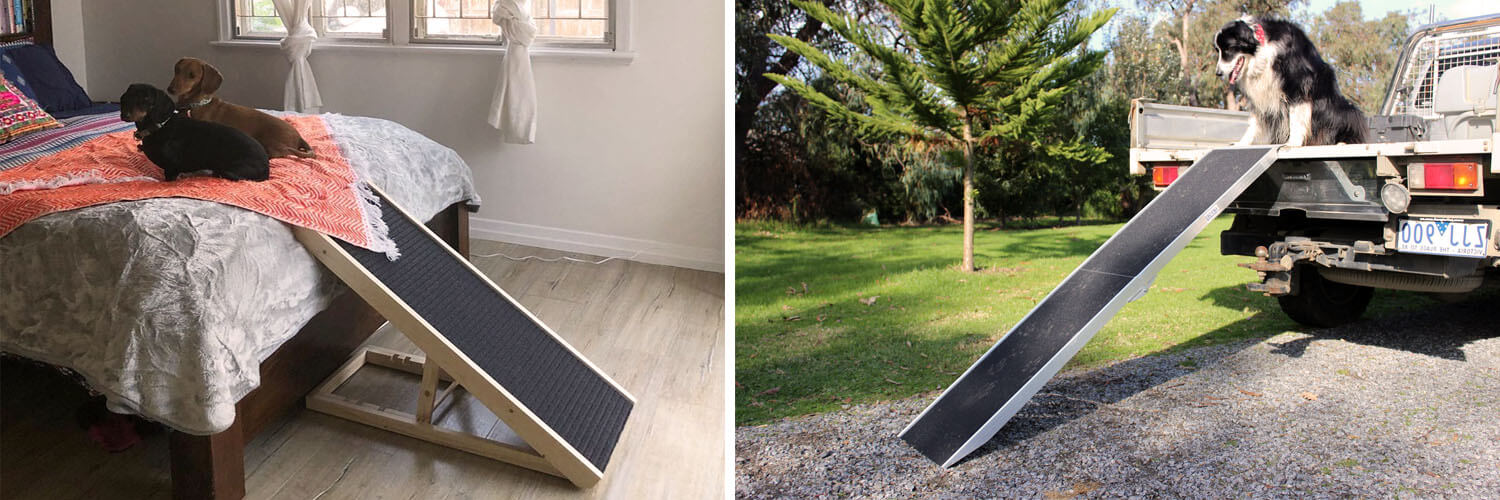
Now let’s get going!
How To Train Your Dog To Use a Ramp
Step 1: Introduce The Ramp
So the first goal is to present the ramp in such a way that it appears less intimidating.
On the first day of training, place the ramp in a place your dog is very comfortable with like the living room. Place it on the floor and just ignore it–completely. Don’t pay any special attention to it and just leave it lying flat on the floor and go about your daily routine.
It wouldn’t take long and soon your ramp will be discovered.
Once your dog goes near the ramp, sniff on it or sit beside it, mark it by saying a positive word like “yes” or “good boy”. That’s a good sign your dog is now ready to get onto the next step.
Note: If your dog loses interest and never goes back to interacting with the ramp, you may need to go back to start by saying a few words of encouragement for just looking at it. You may have to encourage him initially by tossing a treat by the ramp to emphasize that the ramp is what brings good things for him. Do this no more than a couple of times since you want your dog to approach the ramp on his own.
Step 2: Create A Positive Association With The Ramp
Place his favourite treats or toys on top of the ramp while the ramp is still lying flat on the ground and let your dog eat treats off it.
We basically want your pooch to form a positive association with the ramp so that he is no longer reluctant to approach it, but rather is eager to approach it because it has come to represent wonderful things and in this case, his favourite treat or toy!
By this time, you can use any word you want as long as you're not saying an extra-long sentence or similar words used for other cues, and it's important that you stay consistent. You can accompany the cue with a hand gesture that encourages your dog to go near the ramp.
Note: When shaping and conditioning a dog to approach new objects and perform new behaviours, you can use a verbal word such as "yes" followed by a treat. Once your dog approaches the ramp and eats the treat off it, you can say “yes”, “good boy”, or “good job”, to let him know that he’s showing good behaviour.
Step 3: Start Asking For More
Once positive associations are made and your dog is more confident and eager to approach the ramp, it’s time to ask him for more.
Give him a treat only when your dog interacts with the ramp with his paws. Say “yes” when he’s stepping on it with one paw, then with two paws and then three paws.
Once all four paws are up, reward your dog with a jackpot of treats (several treats given at once) as you praise him lavishly. Let him repeat the behaviour several times until he understands that standing on it on all fours is highly rewarding.
If your dog is reluctant in placing his paws on the ramp, you can encourage this behaviour temporarily by tapping on the ramp. Say “yes” and reward for one paw, two paws and then give a heap of treats when he's with all fours on it.
Step 4: Practice Walking Across The Ramp
Now, that your dog has figured out that the ramp is a special place to walk on, it's time to put your dog's brain to work.
The goal is to get your dog to walk across the whole ramp. You can also use your hand with a treat to lure him across and then feed him the treat once he has made it across. Use the food to guide your dog just a few times.
Step 5. Fade the Food Lure
Since we don't want the dog to become over-dependent on the sight of the treat, start fading the food lure.
After using the treat as a lure to get your dog across the ramp, perhaps 4 to 5 times, pretend to have the treat in your hand (when it’s really empty) and use your hand to guide him through the ramp. Once your dog has walked across the ramp, say “yes” as a mark of encouragement and feed him a treat from your other hand.
Step 6. Add a Slight Incline
Once your dog is confident walking across the ramp, it’s now time to add a slight incline on your training.
Increase the incline very gradually. You can start by placing something solid underneath the ramp like a few books. It’s important that you don’t increase the incline too much, to begin with. We want to make sure our pooch never gets scared throughout this process.
Continue encouraging your dog to go up and down the ramp with the slight incline. Then, once he’s mastered the small incline, gradually increase the incline of the ramp by putting it up against something slightly higher like a step.
Continue this process of gradually going higher and higher until you’re ready to place the ramp against the couch.
Propped the ramp up on the couch, with all its cushions removed. Use your verbal cue followed by your hand gesture to guide him up while a helper gently holds him to prevent him from falling or jumping up for extra security.
Once over the ramp, give loads of treats and encourage him to come down. You can also use boxes or chairs placed on both sides of the ramp to prevent your dog from jumping off or accidentally falling.
Step 7. Using The Dog Ramp On Your Car
Now that your dog is more confident using the ramp on the couch, you can start practising, in the same manner, using the car or ute.
Place the ramp securely on your car or ute and stand right beside the ramp so there is no chance of your dog jumping down. Encouraged him up the ramp with word cues that you’ve used when you were practising on the couch.
You want to protect all your hard work by preventing anything negative happening at this point, so if you have a helper, have him help assist your dog up if necessary to prevent scary falls.
Don't forget to lavishly praise and reward your dog with very tasty treats once he’d successfully walked up the car using the ramp.
If your dog loves car rides take him on for one to leave a super positive impression on his mind.

Final Thoughts...
Training your dog to use a ramp only takes a little time and patience–and great treats can certainly speed up the process! Don't forget that teaching your dog a new skill is fun and rewarding at the same time.
Now that your dog is a pro-ramp user, go ahead and get yourself your favourite treat as well, good owner! 😉
Shop Dog Ramps

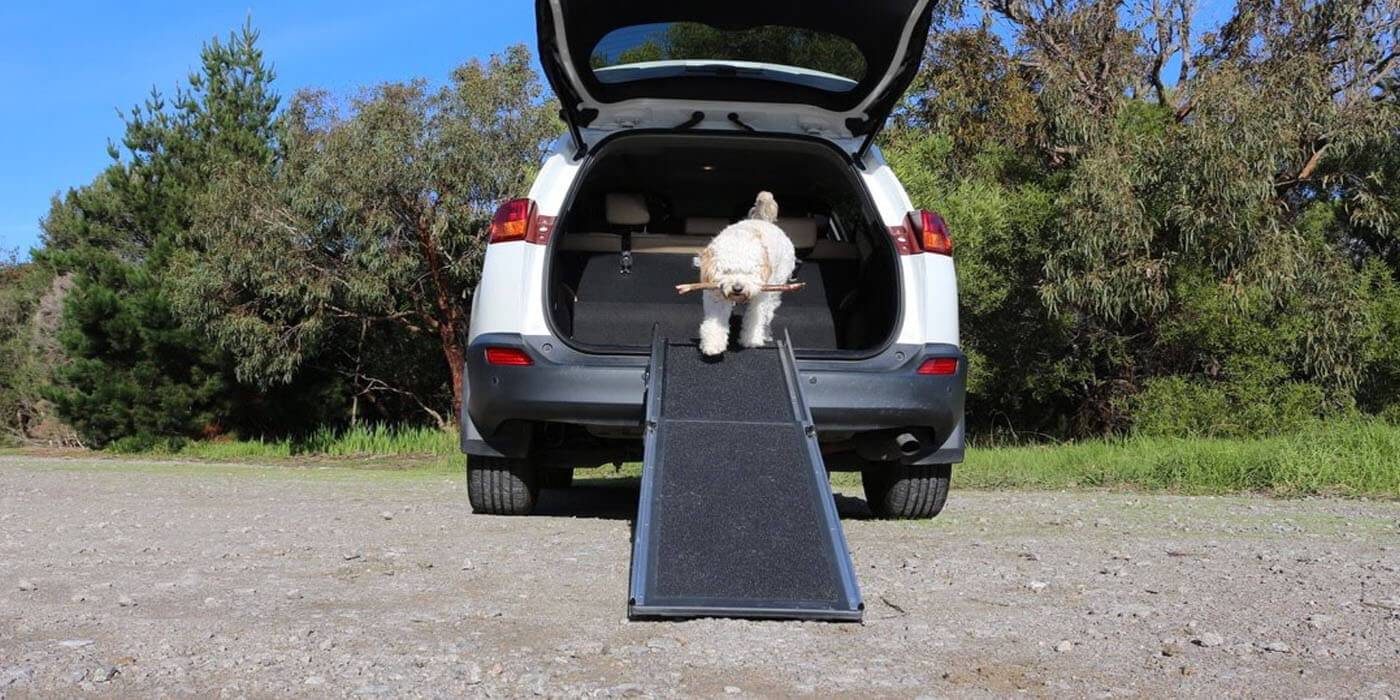
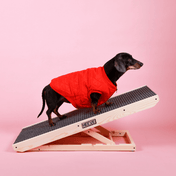
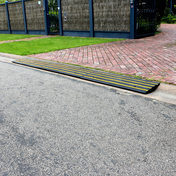
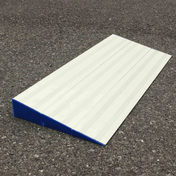
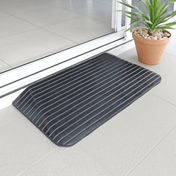
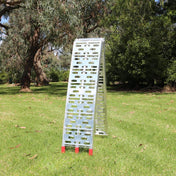
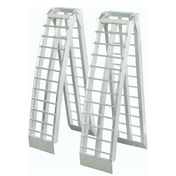
4 comments
My dog has a very bad back leg and can not walk on it what can I do
We have a 97 lb German Shepherd. 10 1/2 years old. Joints are starting to hurt. We got an adjustable ramp. He is more interested in the treats than the ramp. We got him to walk across it on the floor but not really sure he even cared…He wanted the treat. He gets crazy for treats and he gets them all the time lol. We raised it to try to get him to go up it to the bed. No go…He would not put his back legs on it..Same with stairs…His back legs just freeze in place. Going down he seemed too scared to try. Front paws and that was all. I don’t understand how to increase the incline a little each time since there will be nothing on the other end and we can’t expect him to back up or jump off. Can you help?
Hi Heidi,
I suggest giving your dog a scent map. Lure him to the ramp using his favorite snack. Make sure the ramp is laid flat on the floor so he’s comfortable walking over it. Do this a few more times until he gets familiar with the scent and the texture of the surface. Slowly increase the height of the ramp and continue luring him into using it. Make sure that you use simple verbal cues and make him feel safe by constantly touching him – this is very crucial when you start to increase the incline of the ramp.
Hope this helps and good luck! :)
How do I train my blind 8 yr old Aussie mix? I need him to use a ramp to get him to the vet. He’s extremely overweight so I really need to get him use to a ramp. He wants nothing to do with it! 😬😫